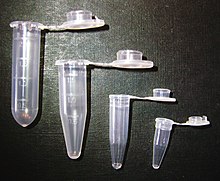Microreaction vessel
Micro test tubes are tubes with snap-on lid for small sample volumes in the microliter range , originally from the company in 1962 Eppendorf Gerätebau Netheler & Hinz were developed.
properties
Microreaction vessels are now offered by the legal successor, Eppendorf AG , and other manufacturers. The vessels are made of polypropylene (PP) and are available in various sizes (0.1 ml to 2.0 ml, since 2013 also 5.0 ml) and colors. They are characterized by their chemical resistance and retain their shape even at temperatures above 100 ° C. They can also be centrifuged at high speeds. The small 0.1 and 0.2 ml reaction tubes have very thin walls and are often used for the polymerase chain reaction (PCR).
The 1.5 ml and 2 ml microreaction vessels are called Eppi in German-language laboratory jargon . In the English-speaking world, these microreaction vessels are called Eppendorf tubes . The designation Eppi or Eppendorf tube has become a generalized brand name internationally , whereby it is not the name of the product brand (such as the German-language use of Tempo for paper handkerchiefs or Tesa for adhesive strips) but the abbreviation of the company's brand that has become established.
Other models of reaction vessels
- Micro reaction vessels with screw caps are suitable for storing medical material such as sera and blood samples as well as for sample heating, centrifugation, etc.
- Microreaction vessels with a sealing cone are suitable for storing sensitive samples as they cannot be contaminated by a silicone seal . These vessels are not autoclavable .
- Microreaction vessels with silicone seals are sealed without the sample being able to touch the sealing ring. They are suitable for storing samples in the gas phase over liquid nitrogen and can be autoclaved at 121 ° C (20 min).
- Microreaction vessels with silicone seals and removal-proof closure give the user an indication of the initial removal. A visible ring works like a seal and is separated from the lid when it is opened for the first time. They have a silicone seal, are also suitable for storing samples in the gas phase over liquid nitrogen and can be autoclaved at 121 ° C (20 min).
Individual evidence
- ↑ Example: Microcentrifuge Tubes. In: Thomas Scientific . Retrieved July 2, 2018 .
- ↑ Example: reaction vessel. In: BRAND GMBH + CO KG . Retrieved July 4, 2018 .
- ↑ Example: reaction vessels, microcentrifuge tubes. In: VWR International . Retrieved July 4, 2018 .
- ↑ Kornelia Ewald: Chemical stability of disposable articles. (PDF, 339 KB) User Guide No 023 . Eppendorf AG, March 2012, accessed on July 2, 2018 .
- ↑ Eppi ™ turns 50 - The microliter system is celebrating its birthday. In: Eppendorf AG. Retrieved July 2, 2018 .
- ↑ Ulrich E. Stempel: DNA experiments. Franzis Verlag, 2016, ISBN 978-3-645-25335-2 , p. 47.
- ↑ Tom Moss: DNA'Protein Interactions. Springer Science & Business Media, 2001, ISBN 978-0-896-03671-0 , p. 96.
- ^ Prakash Singh Bisen: Laboratory Protocols in Applied Life Sciences. CRC Press, 2014, ISBN 978-1-466-55315-6 , p. 1078.
- ^ Daniel Jameson: Methods in Systems Biology. Academic Press, 2011, ISBN 978-0-123-85118-5 , p. 287.
- ↑ Ulrich Görg: Successful brand differentiation. Springer-Verlag, 2010, ISBN 978-3-834-98575-0 , p. 218.

